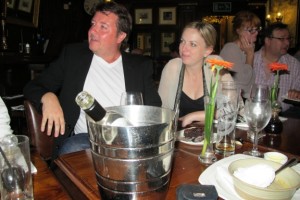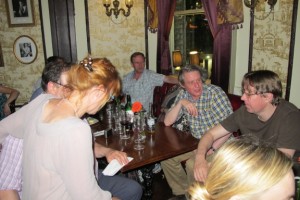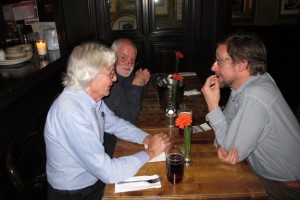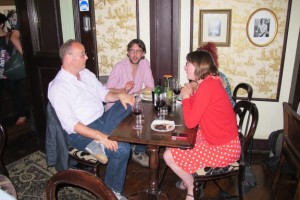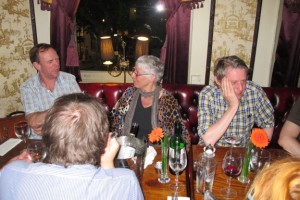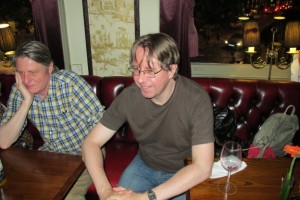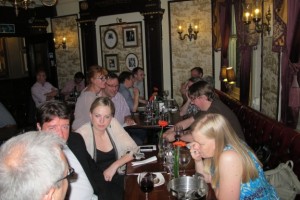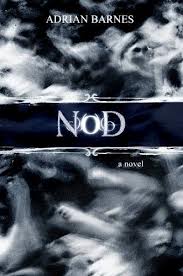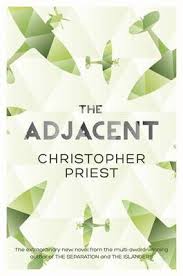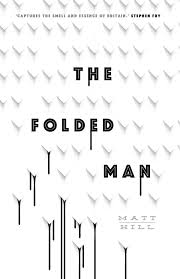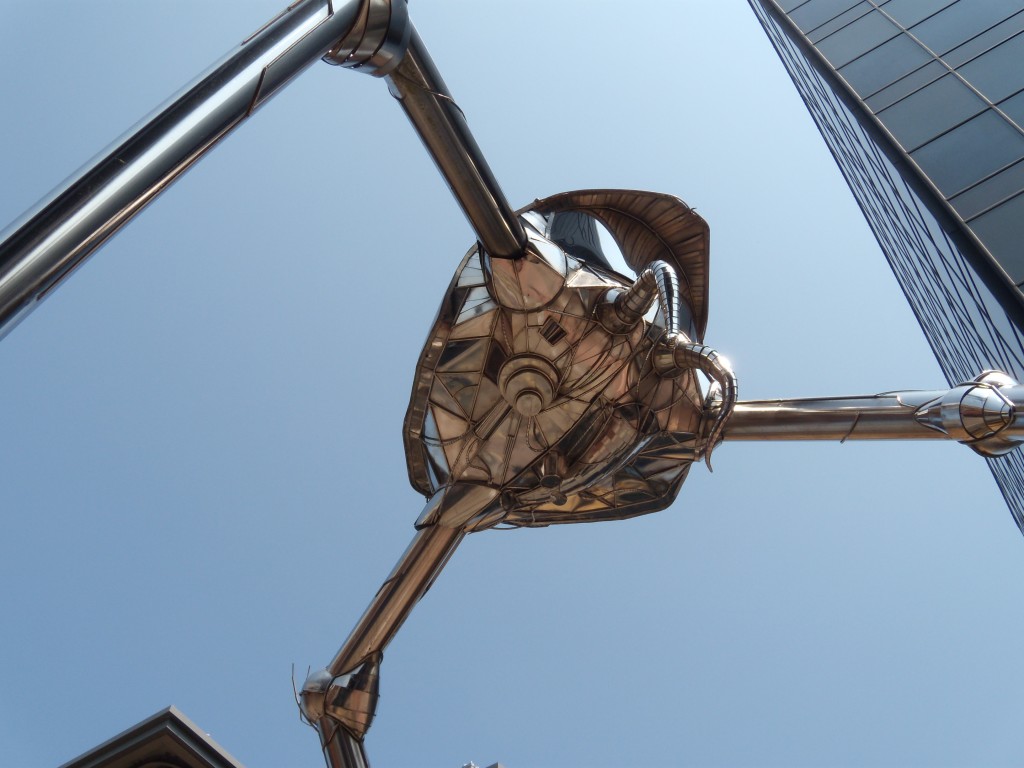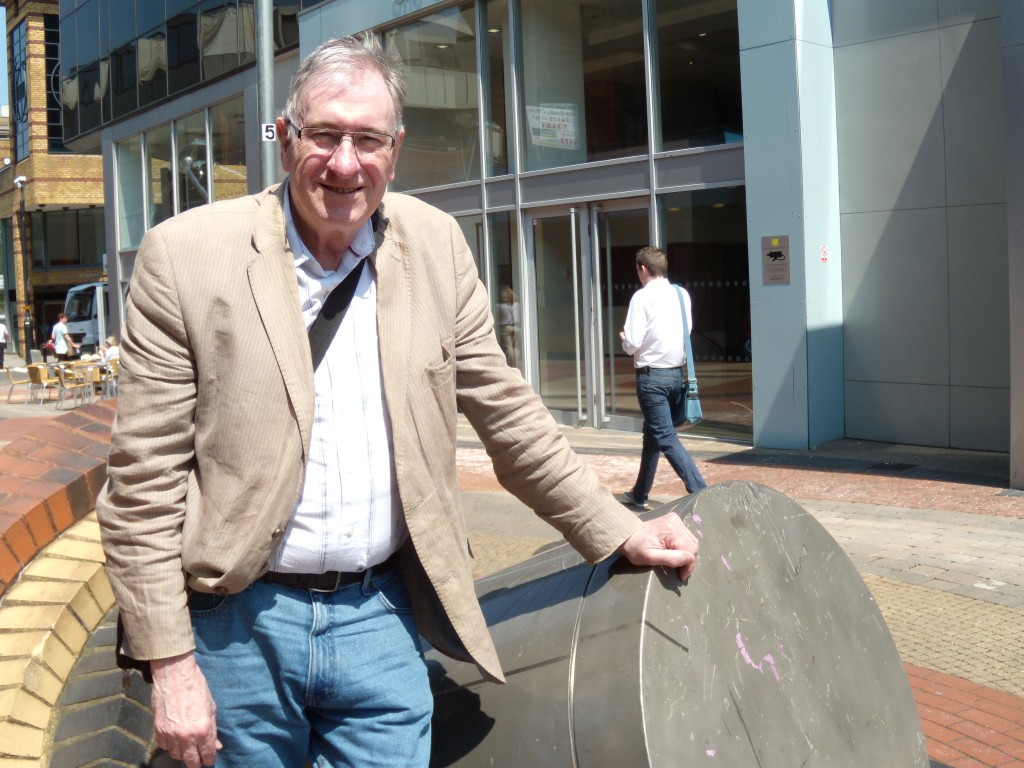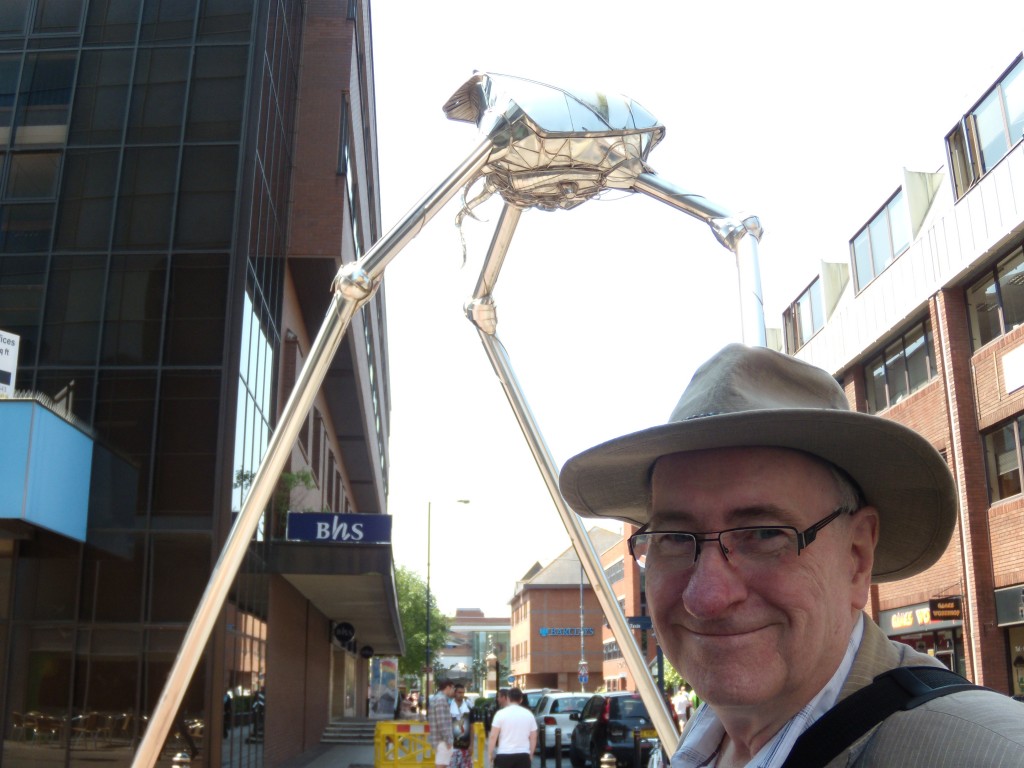Unlikely though it may seem, it’s still not at all uncommon to hear people insisting that there is no issue around the representation of women in F&SF, that a theoretically level playing field means there is no industry bias and no problem, hidden or otherwise. Unfortunately, in a world where, even after the whole BFS horror writers ‘In Conversation’ book debacle back in 2009, the organizers of last year’s Horror in the East festival in Lowestoft managed not to invite a single female horror writer on to their guest list (a fact that has been bugging me for months), that is clearly not the case. There’s been a lot of discussion around this year’s all-male shortlists for both the BSFA and the Clarke Award. The consensus among the cognoscenti seems to be not that women aren’t writing SF, but that they are finding unusual difficulty in getting published.
So what’s going on? There is no single defining answer to that question. What I do know though is that if I happened to have a book or a story shortlisted for an award, in any category, I would be totally appalled if I believed even for a moment that my work had been selected – by a jury or by a readership – for any reason other than for its literary merit. As writer and Clarke judge Liz Williams so rightly points out, the idea that a writer’s gender should be taken into account when judging their work from a literary standpoint is both slippery and dangerous:
“Most of the criticism that we got, as female judges, was from men: for being insufficiently feminist. There was finger-wagging on a number of male-dominated threads as to what I, in particular (as a result of the Guardian article) should be thinking and feeling, and there seems to be an assumption in some quarters that our primary issue, as female judges, should be gender. I need hardly point out how problematic this is.”
Clearly the Clarke judges were in a different position from, say, the organisers of the Horror in the East festival in that they had no control over what was submitted, and by extrapolation no control over what works they were called on to consider. When the Clarke submissions were announced, I did my own little numbers breakdown (because that’s the way I like to spend my spare time, people): works that were ineligible (because by my personal reckoning they contained no science fictional element), works that were SF but didn’t stand much chance of shortlisting (because they were minor works, derivative or spin-off or actively retrograde) and actual contenders. Out of the original 82 works submitted, I counted 33 as genuine contenders. Of those 33, 5 – yes, that’s just 5 – were by women. When you look at it head on like this, it is an outrage. But this situation is not the fault of the judges and they should not be blamed for it. (Farah Mendlesohn’s thoughts on the eligible submissions by women and the whole male shortlist business in general are interesting and valuable in this context – read them here.)
This does not mean that I believe we should say and do nothing about all-male shortlists. What I believe is that we should be positively proactive. By drawing attention (as Liz has done, and as her fellow Clarke judge and writer Juliet McKenna has done also in her excellent post here) to what is happening – in the field of publishing most especially – and most of all by encouraging women who write to believe in their talent, and most crucially to put their work forward for consideration. For me, being proactive means first and foremost being a woman who is a writer of F&SF. It also means actively drawing attention to the work of other women who are writers of F&SF. I have always found the notion that women ‘can’t’ or ‘don’t’ write hard SF or space opera or horror ludicrous, frankly – even saying this out loud makes me angry. But I’m not going to get angry, I’m going to get even – by shouting about the work of writers I love.
Kari Sperring kicked off the #womentoread hashtag last Wednesday – she explains why here at her website – and her initiative quickly started gaining momentum. I immediately wanted to do my bit to support it, and my first thought was simply to list those women F&SF writers who had most inspired me. I hit on 101 as my goal because it seemed like a good number, big enough to demonstrate just how excellent and wide-ranging women’s fantastika is and always has been. It didn’t take me long to compile the list – and there are so many women writers to choose from that I inevitably had to make some subtractions. But then I decided I wanted to do a bit more than just name people. I wanted to talk about them, too, to discuss their work at least a little, to give readers some idea of why these writers are special to me and why they should read them. I wanted to post links to further discussion, views and reviews, to provide access to a bank of information that would help readers and writers find out more and hopefully delve further into this goldmine.
So in an act of madness I decided to do just that. What started as a quick series of jottings snowballed into a labour of love that has taken me a serious number of hours to complete – which is why this post comes to you somewhat later than I originally intended. Every minute I’ve spent on this has been worthwhile, though. It feels fantastic to be reminded of how much talent there is out there, and I hope this list inspires others – readers and writers – as much as it’s inspired me. Most of all I hope that people might discover some names that might be new to them.
So here are my 101 #womentoread. I’ve tried to spread my choices to include writers who are no longer with us, writers who are already established and those all-important new voices. But above all, 101 #womentoread are all writers that mean something to me, all writers who have produced works I can wholeheartedly recommend to others as being amongst the best that speculative fiction has to offer.
I’m only sorry I wasn’t able to go on, to include all those other writers I know I’ve missed. But seriously, I had to stop somewhere. I have stories to write…
Joan Aiken – one of my favourite writers from ages back, I read her The Wolves of Willoughby Chase until my copy literally fell apart. Aiken was an extraordinary talent, a born writer, with a lifelong love of the ghost story and the weird tale.
Margaret Atwood – needs no introduction from me, but the fact remains that she’s a groundbreaker and quite simply a great writer. The first novel of hers I read was of course The Handmaid’s Tale, an immensely powerful work that has never quite slackened its grip on me, although I consider The Blind Assassin, a mystery novel with a strong speculative element, to be her masterpiece.
Nicola Barker – regular readers of this blog will already know how I feel about Nicola Barker. I think she’s one of the most important writers in Britain today. Her 2007 Booker-shortlisted novel Darkmans might genuinely be called a work of genius, and is certainly one of the greatest speculative novels of the century so far. Just read it.
Nina Bawden – a very special writer for me. I grew up with her Carrie’s War and The Witch’s Daughter, and never stopped loving the strength and eccentricity of her voice, her understanding of human obsessions, which for me always gave her writings a whiff of the dark fantastical.
Elizabeth Bear – Another of those writers who just seems born to it – I’m in awe of her work rate – and she’s a good writer. overflowing with imagination and with a facility for language that once again I’m in envy of. I’ve been reading her collection Shoggoths in Bloom this spring and loving it.
Lauren Beukes – F&SF is lucky to have her. I was lucky enough to hear Lauren read a sneaky extract from The Shining Girls in Brighton last autumn, and now I’m anxiously awaiting the delivery of my copy so I can get on and read the rest of it. I’m very excited about this one.
Karen Blixen – Seven Gothic Tales. Say no more.
Elizabeth Bowen – Bowen wrote ghost stories and tales of the strange as a natural part of her output and all her fiction has about it that quality of heightened realism that must qualify much of it as slipstream in any case. Start with The Death of the Heart, an essential study of obsession and buried secrets.
Angela Carter – where to begin with such a magical writer? Penalized by the literary establishment for being a) a woman b) an outspoken woman and c) a woman who wrote fantasy, she is now recognised by anyone who knows their F&SF as the queen of the slipstream. She left us way too soon.
Susanna Clarke – is a perfectionist. She took ten years to complete her debut, the internationally acclaimed Jonathan Strange and Mr Norrell, and has been working on her follow up for almost as long. Which, given the beautiful complexity of Strange, isn’t surprising.
Susan Cooper – I wrote about Cooper on this blog around Christmas time. Inspirational woman, wonderful writer.
Lydia Davis – writes mainly short fiction, but what short fiction! The brevity of most of her pieces belies their impact. She’s interested, above all, in experimentation, in conveying the idea of transience, of secret truths embedded in ordinary moments. Try reading her story ‘The Landing’ to get an idea of what I’m talking about.
Daphne du Maurier – I’ve loved her stuff since I don’t know when. I first encountered her fiction in the form of a battered Penguin edition of her story collection The Blue Lenses, and other strong early memories include the BBC adaptation of her classic suspense novel My Cousin Rachel, with those marvellous opening lines: ‘They used to hang men at Four Turnings in the old days. Not any more, though.’ Du Maurier is one of those rare writers whose popular success tends to obscure the fact that she is also a fantastic writer, period. Do also read Margaret Forster’s excellent biography, one of my favourite literary biographies to date and by another great #womantoread
Katherine Dunn – Geek Love. Just read it.
Jennifer Egan – has finally made her breakthrough with A Message from the Goon Squad, but everything she’s written displays a similar and abiding interest in the speculative, the weird, the original. Her experiments with form have included ‘Black Box’, a dystopian short story published in instalments via Twitter.
Carol Emshwiller – is one of the most gifted short fiction writers currently working. The thing I love about her writing is the way it is both lyrical and tough-minded at the same time. Emshwiller never shrinks from writing about difficult themes – she’s written a whole volume of stories on the theme of war – but she always does it beautifully, meticulously, with an attention to detail and craftsmanship that is invariably the preserve of the true master. She is essential.
Jenni Fagan – she’s a poet, she’s a novelist. Her first novel The Panopticon was a Kitschies finalist this year, and she’s just been named as one of Granta’s Best Young British Novelists for 2013. Her use of language is plastic and alive, her use of imagery is poetic and potent. She has an instinct for the unnerving. She’s at the start of what I’m sure will be a great career.
Penelope Farmer – oh, where to begin. Her children’s novels The Summer Birds and Charlotte Sometimes were some of my earliest introductions to speculative fiction, only I didn’t know they were speculative fiction then, they were just stories I adored. Farmer specializes in finding the extraordinary in the ordinary and I will always feel a huge affection for her work and the inspiration it has provided.
Gemma Files – fantastic horror writer. I was lucky enough to share space with her in Ellen Datlow’s The Best Horror of the Year #2, and you can read her award-winning story ‘The Emperor’s Old Bones’ here.
Karen Joy Fowler – her classic 1991 novel Sarah Canary has recently been reissued as a Gollancz SF Masterwork and about time too. She explores themes of womanhood and women within society and (with Pat Murphy) was co-founder of the Tiptree Award.
Cate Gardner – her novel Theatre of Curious Acts was recently named by Damien G. Walter in The Guardian as ‘one to watch’ and it’s easy to see why. Cate writes dark fantasy with a razor-sharp poetical edge. She’s also a delightful person. She’s well on her way to being a leading light on the UK horror scene and most deservedly so.
Rosie Garland – has been writing poems, stories and songs for years and her first novel, The Palace of Curiosities, has just been nominated for the Desmond Elliot Prize for debut fiction. The Palace of Curiosities is partly set in a travelling freak show and I shall definitely be reading it – can’t wait.
Patricia Geary – I discovered Patricia Geary’s novel Strange Toys when I read Kelly Link’s essay on it in the Newman/Jones compilation Horror: Another 100 Best Books. It’s a fantastic novel, a true classic, and it’s criminal that Geary isn’t better known. I find it saddening to think of the difficulties she has experienced in getting her more recent novels published, when she is clearly a singular and dynamic voice in speculative fiction.
Mary Gentle – her magnum opus to date is Ash, a thousand-page ‘secret history’ that many believe should have won the Clarke in 2001. She writes of empires and colonies, wars and women, and takes delight in parodying commercial high fantasy. You can get a taste of Gentle’s outspoken fiction here.
Rumer Godden – probably best known for her novel of dark obsession Black Narcissus, I personally associate Godden much more with her marvellous works for children, most especially her 1947 novel The Doll’s House, which completely obsessed me (and scared me) when I was younger. Godden lived for some years at Lamb House in Rye, so I can count her as a near neighbour!
Theodora Goss – dense, richly allusive prose, beautiful and strange stories. Goss writes in the evolving tradition known as ‘mythpunk’, drawing on fairy tales and mythology for her source material. A wonderful writer.
Nicola Griffith – uncompromising and radical, Griffith writes about gender, identity, alienation and sexuality. Uncompromising and brave, a literary innovator, Griffith has recently had two of her novels, Ammonite and Slow River, have recently been reissued as Gollancz SF Masterworks.
Xiaolu Guo – previously shortlisted for the Orange Prize and recently listed as one of Granta’s Best of Young British Novelists, Guo’s novel UFO in her Eyes brings SF and social commentary together in fascinating ways.
Sarah Hall – Hall was shortlisted for the Clarke Award in 2008 for The Carhullan Army, which could be described as a women’s dystopia. Her recent collection The Beautiful Indifference is a superb achievement, and continues Hall’s involvement with speculative ideas. You can read Hall’s amazing short story ‘Butcher’s Perfume’ here – now that’s my kind of horror story.
Elizabeth Hand – I love Liz Hand’s writing, period. I love the intensity of her narratives, the power of her descriptive prose. I’m inevitably drawn to her alienated, artistic, outsider character archetypes. She’s also an inspiring speaker and a wonderful person. I’m delighted that she has recently landed a deal with a UK publisher, because her work isn’t nearly as well known over here as it should be. Her most recent novel Generation Loss will be published in the UK in June.
Frances Hardinge – is the writer who’s creating young adult fiction with an adult sensibility. She’s tackling difficult themes – oppression, social exclusion – in original and invigorating ways. Her most recent book is A Face Like Glass, which made the Kitschies Red Tentacle shortlist earlier this year.
Patricia Highsmith – she’s a huge deal for me. I love the directness of her approach, her unfussy, declarative but nonetheless intimately descriptive prose. I love that her crime stories aren’t conventional whodunnits – most of Highsmith is very much about the why, and there are numerous occasions in her novels when the murder in question simply fails to get underway. One of my favourite novels of hers is The Blunderer, which tells the story of a man who comes under suspicion for a crime he planned to commit but never did. Highsmith wrote dark fantasy and even the occasional SF story as well as her psychological thrillers – a fact that deserves to be mentioned far more often. She’s a writer I return to constantly, in admiration and envy. Anyone wishing to discover more about Highsmith’s life and work should read Andrew Davies’s excellent biography Beautiful Shadow.
Susan Hill – she’s best known for The Woman in Black (read the beautifully imagined book, avoid the awful film like the plague) but Susan Hill was important to me long before she wrote that. My mother had all her early stuff in Penguin paperbacks, and as a young teenager I was instantly captivated by the dark, claustrophobic worlds she conjured in I’m the King of the Castle and The Albatross. Her more recent book The Beacon is a mini-masterpiece, a perfectly rendered short novel I wish to God I’d written myself, a story that can be read and reread many times with equal pleasure.
A. M. Homes – is one of the boldest, most out-there writers around. Through the hyper-intensity of her narratives and the often violent weirdness of the characters she writes about, Homes’s stories come to occupy that narrow space between quotidian reality and the fantastic. I found her novel about a paedophile and his victim, The End of Alice, intensely disturbing but utterly compelling.
Elizabeth Jane Howard – is now 90, and she still writes every day. If that’s not an inspiration, I don’t know what is. Her famously colourful life conceals a more private person, whose sensitivity and richly imaginative inner life shines through in her fiction. EJH first published strange fiction in 1951 in We Are for the Dark, an anthology containing three of her own stories and three by Robert Aickman. A collected edition of her ghost stories, Three Miles Up, was published in 2001 by Tartarus Press.
Shirley Jackson – is so essential to the idea of horror fiction that it’s difficult to write about her. Her most well known works are the novel The Haunting of Hill House (turned into a great film by Robert Wise in 1963 and a predictably stupid Hollywood remake by Jan de Bont in 1999) and her short story ‘The Lottery’, possibly one of the most anthologized tales of terror of all time. But there’s so much more to Jackson, and my advice would be to just read everything. Her lesser known but equally disturbing (and my personal favourite) novel We Have Always Lived in the Castle is essential reading for anyone interested in weird fiction, and her many short stories – the prose clear and elegant and starkly descriptive – are characterised by themes of obsession, secrecy and hidden passions. Jackson is a master at blurring the boundaries between the actual and the very strange.
Elfriede Jelinek – always a controversial writer (the decision to award her the Nobel Prize resulted in the resignation of one member of the Swedish Academy) she is all the more essential for that. Her subjects – states of anxiety, the oppression of the individual by a fascistic state, the abuse of women – show the influence of Kafka and Ingeborg Bachmann (just sneaking another great woman writer in there) and the way she assembles her texts – which could bear comparison with found-footage movies – demonstrates her sympathies with surrealism, hyperrealism, and the generally strange. Her most famous work in English translation is undoubtedly The Piano Teacher – one of those rare instances where the film that was made of it (in 2001, by Michael Haneke) turned out to be a powerful complement to the original.
Liz Jensen – I’m in awe of her talent, her imaginative reach, her enviable ability to tell a story. She does such weird things with weird fiction – and she does it with such apparent ease, such lightness of touch. Jensen is a writer who gives her SF full employment – as story, as metaphor, as full-blooded exploration of a speculative idea. She is not one of those mainstream dabblers who use SF as padding, or background colour. You can read a feature on her here at The Independent, a great review of her novel The Uninvited here at Follow the Thread, and Paul Kincaid reviews its precursor The Rapture at the SF Site.
Kij Johnson – first came to my attention through her short story ’26 Monkeys, also the Abyss’. All her stories are extended metaphors of the most pleasing kind – they’re also delightfully inventive, immediately readable works of the fantastic. Allusive, richly textured, just gorgeous writing. Read a lovely interview with Kij Johnson here at Clarkesworld.
Carole Johnstone – is one of the UK’s new wave of new horror writers, and what a talented writer she is. What marks out her stories for me is their sense of place – see her most recent appearance in Black Static, ‘Signs of the Times’, as a case in point. For Johnstone, landscape forms an integral part of her imaginative vision, as richly characterised as any of those characters – alienated seekers – who inhabit it. I understand that Carole is currently working on a novel – can’t wait to see that. Her novella Cold Turkey will be available soon from TTA Press.
Diana Wynne Jones – one of my all-time favourite books as a child was The Ogre Downstairs. Much of my love and fascination for this novel lay in the fact that it revolved around a chemistry set. I was pretty obsessed with this kind of stuff – blowing things up in petri dishes and growing copper sulphate crystals in jam jars – and so the book felt, as all the best books do, as if it had been written precisely with me in mind. It was only as I grew older, and my interest in speculative fiction became more directed, that I began to learn the importance of Diana Wynne Jones as a writer. Not just the lively and often outrageous originality, the compassion that is always evident in what she writes – the twin facets that will make her novels for young people enduring classics – but her whole attitude to fantasy, what it means and what it can do. She understood that fantasy tropes are tough enough to survive any amount of undermining and subversion – her Tough Guide to Fantasyland is an exploration of that very notion. A collection of her essays and autobiographical material can be found in Reflections: On the Magic of Writing.
Gwyneth Jones – is able to blend science fictional elements with mythology and the fantastic in ways few other writers would dare to try. Read Ian Sales’s excellent review of Jones’s story collection The Universe of Things to discover all the many reasons why you should read her. And while you’re there, check out some of the other reviews at Daughters of Prometheus also – a site that specializes in reviewing 21st century SF by women and exactly the kind of initiative that is most welcome.
Miranda July – performance artist, film maker, actor, slipstream writer. Miranda July’s writing is immediate, heightened, intense and hovers constantly on the boundary of the fantastic. In his Guardian review of her collection No One Belongs Here More than You, Josh Lacey said this: “Fantasy is vital to July’s characters. Her stories are populated by sad, lonely, isolated people who feel a terrible dissatisfaction with the failure of their lives to match the drama and intensity of their dreams.” Do read the whole review – it also gives a lot of background info on July’s writing. (And I thoroughly recommend her film The Future, too. Some reviewers have found it too whimsical but I found it hauntingly sad, strikingly original and exquisitely scripted. One of my faves from last year’s DVD catch-ups.)
Anna Kavan – is still not half so well known as she should be. Her novel Ice is a core slipstream text and could be counted as the great novel of the SF New Wave by a writer who wasn’t part of the New Wave. Her style exhibits a directness, a muscularity and a facility with fantastical imagery that many lesser writers might kill for. Read Ice first, then read everything else. Seriously. My favourite after Ice is her novella The Parson. Another perfect slipstream novel in miniature and with a magnificent sense of place.
Joanna Kavenna – another of this year’s Granta Best of Young Brits who also happens to be a writer with sound speculative credentials. Her novel The Birth of Love employs multiple narrative strands – past, present and future – to explore ideas of female identity, women’s ownership of their own bodies, and society’s treatment of women as mothers.
Rachel Kendall – is all round awesome. Her speculative zine Sein und Werden specializes in tales of the surreal and seriously strange, and own writing interests bear this out in spades. Kendall displays a thirst for experimentation and originality that is all too rare. Check out her collection The Bride Stripped Bare to see what I mean.
AL Kennedy – is one of Britain’s finest writers, full stop. Her dense, allusive, strangely textured narratives verge on hyperreality and her narrators’ haunted internal monologues offer a view of the world that attracts as much as it disturbs. Why her most recent novel The Blue Book, with a psychic as protagonist, wasn’t shortlisted for the Booker remains a complete mystery.
Leigh Kennedy – is one of science fiction’s best kept secrets. Her two novels to date, The Journal of Nicholas the American and Saint Hiroshima, are persuasive, original and so well written they deserve to be classics. There are rumours of a new novel in progress and it can only be hoped that this might help to bring Kennedy some of the recognition she surely deserves. I reviewed Kennedy’s newest collection Wind Angels for Strange Horizons here.
Caitlin R. Kiernan – I first encountered Kiernan’s short stories in Best New Horror and Dark Terrors anthologies from the early 2000s and it was immediately apparent to me that she was a writer apart, a writer whose lyrical intensity and imaginative reach delved into places barely hinted at by some of the others who shared her publication space. She is seriously special, seriously brave and so seriously talented it might land me in some serious bouts of teeth-gnashing, if I didn’t love her work so much. If you read one horror novel this year make it The Drowning Girl, as great as Peter Straub’s great Ghost Story and a modern masterpiece.
Katie Kitamura – is a powerful new talent whose debut The Longshot was reviewed excellently here by David Hebblethwaie and whose follow-up, Gone to the Forest, explores issues of power, colonialism and dying empires against a background that has about it the heightened details and forbidding depths of a strange dark fantasy. Kitamura is seriously gifted and strikingly original.
Käthe Koje – is like an even darker, even weirder Angela Carter. Her protagonists are outsiders, her language is as dense and edgy as the situations those protagonists get into. She’s a horror writer but like all the best horror writers she’s so much more than ‘just’ that. Read Strange Angels and go on from there.
Margo Lanagan – I discovered Margo Lanagan when Chris recommended that I read her collection Black Juice. I loved it immediately. Her way with the fantastic is so subtle and so strange and so much her own. The story that kicks off Black Juice, ‘Singing my Sister Down’ became a classic almost instantly and it deserved to. She’s just a damn good writer and I’m glad she’s out there, doing what she does so powerfully and so well.
Tanith Lee – I have a deep affection for Tanith Lee’s stories, which I discovered when I was first starting to write seriously in the early 2000s. She’s probably best known for the trove of fantasy novels she published in the 80s and 90s, but I treasure her most when she’s writing on contemporary themes in a contemporary setting. This is where her lyrical power comes into its own. You can read her story ‘Midday People’ here, one of the very first of hers I read and that I still remember with indebtedness and with delight.
Ursula Le Guin – I hope she wouldn’t mind me saying this, but in a very real way she is the mother to us all. One of the most important figures in contemporary SF, one of the most inspirational figures for women who write speculative fiction. I first read her Earthsea novels when I was about twelve. They flowed into me more or less from the first sentence and never left. Le Guin’s sentences are perfectly crafted, she continues to explore serious ideas with a zest and alacrity few can emulate. Read the SF Site’s featured review of one of Le Guin’s core texts, The Lathe of Heaven, here.
Doris Lessing – has shown a strong interest in speculative ideas throughout the length of her career, starting with Briefing for a Descent into Hell in 1971, continuing with the Shikasta novels in the early eighties and then later works including Mara and Dann (1999) and The Cleft (2007). She once called her post-apocalyptic London novel Memoirs of a Survivor (1974) ‘an attempt at autobiography’. Her SF can be a little heavy handed at times but her voice has such power and her intentions are so serious that she’s essential reading. Unlike some other writers who are best known for their mainstream fiction she has never seemed afraid or ashamed of admitting her SF credentials. I was lucky enough to hear Lessing speak at a LRB event celebrating the work of Anna Kavan in 2007 and I found her inspiring, a beacon for us all.
Kelly Link – I first read Kelly Link when her story ‘Magic for Beginners’ was shortlisted for the BSFA Award alongside my own ‘Bird Songs at Eventide’ in 2005. Given that my story is an early prentice piece and Link’s is an expansive, expressive, goddamned beautiful masterpiece that shortlisting looks pretty funny, side by side. I’ve read almost everything she’s written since and all I can say really is that I wish she’d write more! If you’ve not read her yet, then do, seriously, please – start with her collection Pretty Monsters and then seek out every other story she’s written and swallow it whole.
Clarice Lispector – died tragically young, of cancer, at the age of fifty. Fortunately we have her work to remind us of what an extraordinary, original and unique writer she was. A magical realist, a metafictionist, a surrealist – Lispector is all of these, and still hard to define, which is a great thing. Get a taste of her fiction here.
Alison Littlewood – writes such great horror, well crafted and very personal and sincere. There’s a vulnerability to her characters that makes you fear for them, even as you’re anxiously turning the pages of her stories to find out what will happen. Her first novel A Cold Season has done much to get her name out there to a wider audience, and I’m sure her new book Path of Needles, out this May, will consolidate her reputation as one of UK horror’s rising stars.
Livia Llewellyn – her collection The Engines of Desire is one of the best debuts I’ve read in recent years. Llewellyn’s stories are often so dark in tone they’re painful to finish (see her nuclear war story ‘Horses’) but they are just so, so good you have to finish. My favourite of hers so far is a superb Lovecraft-influenced novella Her Deepness, which by luck you can read for free here at Subterranean Online. It’s a superb piece, and one that has stayed with me more than any other single story I’ve read in the past five years. She’s an awesome talent, and I’m hoping we’ll see another collection from her before too long.
Hilary Mantel – is best known for her prizewinning historical novels set during the time of Thomas Cromwell. These books are grand historical fantasias in their own right, of course, and I’ve said before that writers of epic fantasy could do a lot worse than to look to Mantel as an example of what fantasy should aspire to, both in terms of imaginative reach and in terms of style. But Mantel has also written more overtly fantastical material. Her novel Beyond Black, about a travelling psychic and her assistant, is beyond brilliant. (I named it as one of my top 5 novels of the 21st century in the recent Locus poll.) There’s also a creepy mystery set in Saudi Arabia (where Mantel lived for a time), Eight Months on Gazzah Street, and The Giant, O’Brien, set in the eighteenth century and woven around the journey of the famous giant from Ireland to London and what happens to him there. Mantel’s narratives often focus on troubled misfits. There is a touch of the dark fantastic in all of them.
Helen Marshall – I first discovered Helen Marshall’s fiction when I heard her read her story ‘Blessed’ at last year’s FantasyCon. The story impressed me so much I quickly went on to read the whole collection, which I later reviewed for Strange Horizons. Helen Marshall is seriously gifted. If I had to pick one word to describe her writing it would be audacious. Her stories are so strange and so beautiful, so original and so well crafted – a Marshall story summarizes what we mean when we say ‘best new horror’. I understand that Helen is currently working on a novel and I for one can’t wait to see what she comes up with. You can read one of my favourite stories from her collection here at Weird Fiction Review.
Valerie Martin – her 1990 novel Mary Reilly retells Robert Louis Stevenson’s The Strange Case of Dr Jekyll and Mr Hyde – from the perspective of Dr Jekyll’s devoted servant Mary. It was nominated for both the Nebula and the World Fantasy Award, and the film adaptation starring Julia Roberts is actually not half bad. Martin has a fascination with dark, obsessive temperaments and with hidden secrets, and her novels Italian Fever and The Confessions of Edward Day among others focus upon these aspects. Her story collection The Unfinished Novel and Other Stories is full of weirdness. Martin’s prose is never less than superb. There’s something of Patricia Highsmith about her and she is just a dman good writer. Read her!
Claire Massey – edits the online speculative fiction magazine Paraxis with Andy Hedgecock. Her own stories have appeared in anthologies such as the bird-themed dark fiction anthology Murmurations, edited by Nicholas Royle, and two of her longer stories, ‘Marionettes’ and ‘Into the Penny Arcade’ are available as standalone chapbooks from Nighjar Press. Claire has a particular interest in folklore and fairy tale, and her beautifully crafted, quietly affecting stories are also characterised by a strong sense of place. She is such a thoughtful, talented writer and I love her stuff. She deserves to be far better known.
Maureen McHugh – wrote the 1992 novel China Mountain Zhang, in which China has become the world’s most influential power and the USA has undergone a communist revolution. Her recent collection After the Apocalypse explores themes of mothers, daughters and survival in extreme circumstance. She also writes alternate reality games. My only complaint about her is that she doesn’t write more! Enjoy her story ‘A Coney Island of the Mind’ here.
Lydia Millet – was shortlisted for the Clarke Award in 2007 for her novel Oh Pure and Radiant Heart, an alternate history focussing on Oppenheimer and the American nuclear weapons programme. Millet is normally marketed as a writer of mainstream literary fiction but most everything she’s written contains a speculative element of some kind and it’s a great shame that she’s not better known to SF readers. Her books are philosophical journeys disguised as great stories – which has to be one of the hardest literary tricks of all to pull off. She’s also written YA speculative fiction on themes of environmental damage and pollution. Her most recent adult fiction is Magnificene, a novel set in an enormous mansion filled with stuffed animals.
Jan Morris – was also shortlisted for the Clarke Award in 2007, for her novel Hav, a traveller’s odyssey to a mythical land, based around Morris’s own experiences in the Balkans. Hav is written with all the seriousness, acuteness of observation and glorious articulacy of her realworld histories and travelogues and really, it’s just a superb book by a superb writer. It should ideally feature somewhere in every one of those ‘100 Best Fantasy Novels’ line-ups that SFF readers – listmaniacs all – argue over so regularly and with such passion.
Pat Murphy – her novel The Falling Woman, the story of a troubled relationship between a mother and a daughter with Mayan goddesses thrown in for good measure, won the Nebula in 1987, although The City, Not Long After, set in a post-apocalyptic San Francisco, is probably her best known work. Murphy founded the Tiptree Award with Karen Joy Fowler and has been tirelessly active over a long period in the promotion of SF by women. Please do go here and here to sample some of her wonderfully evocative and inventive short fiction.
Edith Nesbit – I can’t imagine my childhood without E. Nesbit, whose fantasy novels for young people include Five Children and It, The Phoenix and the Carpet, The Story of the Amulet and of course The Treasure Seekers, all among my very first introductions to speculative fiction. I was delighted to discover relatively recently that for 22 years Edith Nesbit lived close to where I lived in London, at Well Hall in Eltham.
Joyce Carol Oates – I wrote a post for the TTA Press blog as part of Women in Horror Recognition Month in 2011 in which I discussed a few of her many novels and also did my best to explain just some of the reasons why Joyce Carol Oates is my hero. Oates is one of those writers that, once I get reading her, I find it difficult to break out and read anyone else. For me, she is the absolute epitome of the literary fantasy writer, the horror writer who could, the Great American Novelist. I never get tired of her, I can always read more of her, I will forever be in awe of her genius. And I don’t use that word lightly. Anyone who can write as much as Oates has – and don’t forget she’s an esteemed literary critic and teacher as well as a writer – with no diminution in quality from book to book just has to be a genius of some description, I can think of no other word for it. My next Oates up will definitely be her new one, The Accursed. She’s one of the biggest inspirations in my life.
Helen Oyeyemi – began writing her first novel, The Icarus Girl, while she was still at school. She was hailed as a prodigy, and although I bought The Icarus Girl and loved it – it’s about a young girl who finds herself torn between two nations and two heritages whose imaginary friend just might be an emissary from the spirit world of her ancestors – I felt some reservations about the massive exposure she was getting. She was still so young – would she still be writing in five years’ time, let alone able to fulfil the promise of that extraordinary debut? I needn’t have worried. Oyeyemi is still very young – at just 29 years of age she is the youngest of this year’s Granta list – yet each of the three novels she has produced since writing The Icarus Girl shows an increase in scope, in self awareness, in ability, in willingness to experiment and push her own boundaries. To describe hers as a rare talent is an understatement. I find it difficult to put into words, just how much I love and admire her ghost story White is for Witching, which I consider to be as great a contribution to the literature of the uncanny as Shirley Jackson’s The Haunting of Hill House, and the omission of her most recent book, the slipstream novel Mr Fox, from the 2011 list of Booker contenders remains a mystery that will most likely never be solved. Helen Oyeyemi is such a good writer she makes me cry with pleasure. I think she has a new book out next year and I can’t wait to get my hands on it.
Philippa Pearce – is most famous for her award-winning novel for young people, Tom’s Midnight Garden. which I read and loved, but for me the name of Philippa Pearce will always be associated with her collection of YA horror stories The Shadow Cage and Other Tales of the Supernatural. I was given the book for Christmas one year – I must have been about ten – and I read it so many times I almost knew it by heart. What I loved most about the stories in The Shadow Cage was that they all took place against a background of apparent normality and revealed the unease and sometimes horror to be found in everyday objects. (One of my favourites involved a biscuit barrel and a mousetrap!) I had no idea until then that such stories existed, but from the moment I first read Pearce I was greedily on the lookout for more of them.
Ludmilla Petrushevskaya – if you love Angela Carter you will also love Ludmilla Petrushevskaya. Her stories read almost like folk tales – but they’re streaked through with modern ironies and take place against the backdrop of present day Russia, often focussing on the difficulties experienced by women in a country still experiencing significant social problems following the massive political upheavals of the late 1980s. Her first book to be translated into English was There Once Lived a Woman who Tried to Kill her Neighbour’s Baby, recently followed by There Once Lived a Girl who Seduced her Sister’s Husband, And he Hanged Himself. Her style is delightful – witty, talkative, like a wicked best friend – and artfully conceals a grim seriousness.
Sarah Pinborough – Sarah is one of the best things to have happened to British horror in recent years. Her work, which dextrously mixes the fantastical with crime elements, has been commercially very successful, and I can only hope that this is proving an inspiration to other, newer women horror writers coming up, because as well as being successful Sarah is also a very good writer. Her prime motivator is always story – but she never neglects her craft and I feel a great admiration for that. She works bloody hard, and takes every commission seriously. I recently shared space with her in the Solaris haunted house anthology House of Fear, and I thought Sarah’s piece, ‘The Room Upstairs’, was one of the best in the volume. My favourite thing of hers that I’ve read so far is her British Fantasy Award-winning novella The Language of Dying, which is an exquisitely poignant story about bereavement and a great showcase for her considerable talent.
Kit Reed – one of the most idiosyncratic, unclassifiable and underappreciated writers in the field. Her storytelling talent seems endless, and endlessly diverse. If you like Kelly Link and Carol Emshwiller you will love Kit Reed. See this excellent overview from Paul Kincaid and Chris Kammerud right here.
Rochita Loenen-Ruiz – a new voice, and a new perspective. Rochita’s story ‘The Song of the Body Cartographer’ was shortlisted for this year’s BSFA Award in the short fiction category. Reading it, I was struck at once by the beauty of Loenen-Ruiz’s language, her poetical sensibility. I understand that this story is actually a part of a novel in progress and if this is so then I’m most certainly looking forward to reading more of it.
Karen Russell – I was instantly delighted by Russell’s debut collection St Lucy’s Home for Girls Raised by Wolves and have been a fan ever since. Karen Russell first began to gain a profile in the UK when she was chosen as one of Granta’s Best of Young American Novelists in 2007 and all kudos to Granta for flagging up her talent. Again, if you enjoy Kelly Link and Margo Lanagan and their twisting of everyday realities into unusual shapes then you should add Karen Russell to your reading list immediately. Check out Mike Harrison’s insightful review of her most recent book, the enticingly-titled Vampires in the Lemon Grove here.
Jane Rogers – won last year’s Clarke Award with The Testament of Jessie Lamb, the story of a young girl with an important decision ahead of her. Rogers has said she’s a fan of John Wyndham, and indeed it’s not hard to spot his influence in this beautifully written, thoughtful and questing SF novel. And Rogers is no ‘SF tourist’ – she’s already spoken of her intention to write more science fiction, and there are speculative elements in her earlier work also. Her novel The Ice is Singing takes place against a distinctly Kavan-like frozen landscape, and employs a fragmented narrative technique. Her story collection Hitting Trees with Sticks is full of weirdness. Rogers, with her understated and thoughtful way of approaching an issue, is exactly the kind of writer SF needs.
Joanna Russ – the pioneer of feminist SF and SF criticism, her novels The Female Man and We Who Are About To are core texts in the genre. The Female Man interweaves narratives told from the perspective of four different women who inhabit four different realities. We Who Are About To, a subversion of the Robinson Crusoe-type narrative, examines how responses to a crisis situation might be informed by gender. Russ’s critical writing is equally forthright and indispensible. Her book How to Suppress Women’s Writing displays Russ’s sardonic sense of humour in foregrounding vital issues, and her essay ‘The Wearing Out of Genre Materials’ is perhaps the first attempt to define what we mean when we say that SF is ‘exhausted’.
Josephine Saxton – is one of the very few women to be associated with the SF New Wave. Her narratives are often internalised, pitting the vast and unrestricted realms of innerspace against an obstructive reality, and her protagonist Jane Saint – a cypher for Saxton herself, possibly – constantly finds herself under pressure to conform to the demands of a patriarchal society. Saxton was shortlisted for the Clarke in its inaugural year (1987 – Margaret Atwood won with The Handmaid’s Tale) for The Queen of the States, a novel that uses SF allegorically – something Saxton is fond of doing – to examine a woman’s journey to self-liberation. Saxton is a radical writer, never afraid to experiment with form. The visual arts are important in Saxton’s work – she is herself a painter. Cheryl Morgan shares her impressions of Saxton here.
Ekaterina Sedia – writes steampunkish urban fantasies, secret histories and fabulations tinged with darkness and much intrigue. Her novel The Alchemy of Stone won a place on the 2008 Tiptree honour list, and Sedia’s narratives are frequently centred around issues of social and societal oppression of women and minorities and the evils of colonialism. Her 2007 book A Secret History of Moscow rewrites Russian history to include monsters and demons.
Angela Slatter – burst on to the horror scene a couple of years ago when her debut collection Sourdough was published to wide acclaim by Tartarus Press. I first heard about her from Rob Shearman, who was impressed, and I was too. Her writing is rich and poetic, and draws inspiration from the darker sides of fairy tales. You can read a great interview with Angela here at Clarkesworld.
Olga Slavnikova – was born close to Ekaterinburg, in the Ural mountains, the daughter, appropriately enough, of a Soviet rocket scientist. When asked (in a superb interview – just ignore the Amis parts!) why she believed science fiction has always been popular in Russia, Slavnikova said this: “It happens because Russian life is itself at the core fantastical. Sometimes in order to resolve a particularly complex mathematical problem, you have to put an imaginary entity into the equation. Similarly, in order to explain the situation in Russia, sometimes what you have to do is take an element of imagination, of fantasy, enter it into this equation and then the entire situation somehow unfolds and becomes much clearer.” Her novel 2017, which won the Russian Booker Prize, is set in an alternate future exactly one hundred years after the Russian Revolution.
Sofia Samatar – her first novel, A Stranger in Olondria, tells the story of how a youth from an oral culture discovers the meaning and value of written language. It’s had some amazing press already, and I shall be reading it as soon as I can. In the meantime, I’d very much reccomend that you pop over to The Qwillery, where Sofia answers some questions about how A Stranger in Olondria came to be written, and then check out her stunning short story ‘Selkie Stories are for Losers’, one of my favourite short fictions of the year so far and one I shall definitely be nominating for awards on next year’s ballots.
Johanna Sinisalo – says she was fascinated by stories of space travel and mythical creatures from a very young age, and that Comet in Moominland was her favourite of Tove Janson’s novels precisely because it combined these two key elements. The landscape of her native Finland, and wild places generally have exerted a profound influence on her work – the first of her novels to be translated into English, Not Before Sundown, involved the secret history of trolls and takes place against the backdrop of the great Scandinavian forests, and a later work, Birdbrain, is set in the Tasmanian outback.
Ali Smith – I’d been reading bits and pieces by Ali Smith for years, admiring both the writing and the writer’s attitude, but when I finally read The Accidental last year I was blown away by it. It’s one of those novels that is just so good you can only talk about it in superlatives – then tell your bemused interlocutor to go away and read it. Ali Smith is as interested in the ways we tell stories as in the stories themselves, and her recent book Artful combines actual fiction with a series of lectures on the art of fiction. I love this kind of stuff – especially as Smith is obviously a big fan of speculative ideas. Her 2001 novel Hotel World, shortlisted for both the Booker and the Orange Prize, is actually a ghost story.
Kim Lakin Smith – likes to write about outsiders. Her first novel, Cyber Circus, followed a group of circus performers as they battled to secure their freedom in a depleted and often terrifying world. Kim is currently working on a new book, Curtain Falls, which sounds like it has a distinctly theatrical feel to it also. I love Kim’s work – it has soul and it has beauty. She’s a very talented writer and I’m looking forward to seeing her win her first big award.
Tricia Sullivan – won the Clarke Award in 1999 with Dreaming in Smoke and was shortlisted in 2004 for Maul and then again in 2011 for Lightborn. Sullivan writes deeply involved, investigative science fiction containing bold ideas and cleverly intertwined narrative strands. You sense in her work a constant need to find answers to difficult questions, a seeking after the spiritual as well as the scientific facts of life. I know she has been working on a new book, and the extracts I’ve had the privilege of reading have been ambitious, profound, rendered in her trademark style, what might almost be called forensic lyricism. She’s amazingly talented. It’s a matter of deep regret that many of her books are no longer in print – thus underlining the very problem that Liz Williams and others have been talking about. Read Justina Robson’s review of Maul here.
EJ Swift – Emma made her fiction debut in Interzone early in 2012 with her story ‘The Complex’. Her first novel, Osiris, followed shortly afterwards. Osiris tells the story of two young people, Adelaide and Vikram, who are born to opposing sides in the struggle to gain control of the city of Osiris, the last refuge of humanity following a global environmental catastrophe. For me, the most exciting thing about Osiris is the quality of the writing. Swift is clearly a writer of some talent, with a gift for imagery and a quality of lyricism that promises much for her future. The execution scene that opens Osiris is unforgettable. The second book in the trilogy, Cataveiro, has just been delivered and is due for publication later this year.
Rachel Swirsky – her short fiction – elegaic, lyrical, persuasive – has won numerous awards and been nominated for even more. She is also vigorously proactive in the field of SFF criticism, and I for one would be lost without her annual summings-up of the year’s best short fiction in its various categories. I am hoping she’ll delight us with a novel at some point. Read her story ‘The Monster’s Million Faces’ here.
Anna Tambour – her novel Crandolin is a fine example of that slippery edge-of-genre genre we call slipstream, although I suspect that Anna Tambour is the kind of writer who would laugh in the face of genre boundaries altogether. Anna Tambour’s writing is just… Anna Tambour’s writing. Read her story ‘The Oyster and Alice O’ here.
Karin Tidbeck – with the English language publication of her story collection Jagannath, Karin Tidbeck’s profile has been on the rise and deservedly so. Her stories are strange, surreal, sometimes unnerving, always compelling. Rather than playing with or subverting mythologies, they create their own. If you enjoy Kelly Link or Karen Russell you will enjoy Tidbeck too. Her first novel Amatka has recently been bought by Sweden’s largest publisher, and Karin is currently working on an English translation. You can read an excellent interview with Karin here, and read one of the stories from Jagannath, ‘Brita’s Holiday Village’, at the World SF Blog.
Lisa Tuttle – always knew she wanted to be a writer, and first began making her mark when she won the John W. Campbell Award for best new writer in 1974. She moves with ease between horror, science fiction and fantasy, but whatever genre she happens to be writing in, her stories and novels have in common a preoccupation with the inner lives and problems of ordinary people – no matter if they happen to live on this planet or not – and with an emphasis on women’s perspectives and dilemmas in particular. As well as being a versatile and deep-thinking writer, Lisa is also an inspiring teacher, and her book Writing Fantasy and Science Fiction is one of the most insightful and useful I’ve read.
Catherynne Valente – queen of mythpunk! That’s meant fondly but actually it’s wrong to categorize her. Valente is just a wonderful writer. Yes, she draws a lot of inspiration from myths and fairy tales, but the thing you inevitably return to in any discussion of Valente’s work is her use of language, the rich organic fecundity of her sentences. Her books will survive to become classics. You’ll see what I mean when you read her story ‘Urchins, While Swimming’ over at Clarkesworld.
Genevieve Valentine – I’d read lots of good things about Genevieve’s first novel Mechanique but the reviews did not entirely prepare me for the experience of reading it. This is a lovely book, gorgeously written, rich in metaphor and just a damn good story. I loved it and I wish I had written it. And as if that wasn’t enough, Genevieve is also a perceptive and intelligent SFF commentator. Pure gold. I hope we’ll see a new book from her soon.
Jo Walton – has immortalized her love of science fiction in her multi-award-winning novel Among Others, the story of a Welsh teenager who begins to discover her identity through reading science fiction. I enjoyed the fannish references almost in spite of myself, but for me the most successful aspect of Among Others was the voice of its young narrator, Mori. Her beautifully rendered Welsh cadences stayed with me for a long time afterwards. Jo continues to proselytize for SF through her enjoyable and informative blog posts at tor.com.
Kaaron Warren – My first experience of reading Warren came out of a FantasyCon goodie bag! Her debut novel Slights was one of the freebies handed out at the con in Nottingham, I think it was. I started reading the book out of curiosity on the train home and was thrilled by how good it was. The story itself was a page-turner from the start – and the writing was fantastic. I became a fan pretty much overnight. Kaaron writes horror, but it’s never ‘just’ horror. The strength of her stories always lies in her characters and a sense of place that is always fearsomely tangible. A particular favourite of mine is ‘The Gaze Dogs of Nine Waterfall’ and by an almighty stroke of luck you can listen to it here at Tales to Terrify.
Kate Wilhelm – I finally caught up with some of Wilhelm’s work last year when I read her collection The Infinity Box. I loved what I found – the title story especially – and I was struck by the fact that her subtitle for the book was ‘a collection of speculative fiction’. Her choice of the term speculative fiction in preference to science fiction struck me as significant, and knowing, and I liked that, too. I shall most definitely be reading more of her.
G. Willow Wilson – converted to Islam while she was at university and now divides her time between Egypt and the USA. Her novel Alif the Unseen is set in an unnamed Middle Eastern country and with a young computer hacker as its protagonist. Somewhat surprisingly it didn’t make it to any of the major SFF awards shortlists this year – but it did make the longlist for the Women’s Prize for Fiction. Given the mainstream’s habitual suspicion around anything that looks a bit skiffy this was a considerable achievement.
Jeanette Winterson – author of Oranges are Not the Only Fruit, the landmark memoir of a lesbian teenager growing up in a strict religious community, Jeanette Winterson needs no introduction from me. A modernist and always an innovator, she has used speculative ideas in her fiction from early on, most recently in her eco-SF novel The Stone Gods and in her short novel inspired by the Pendle Witch Trials, The Daylight Gate. When asked whether The Stone Gods was science fiction, Winterson said this: “I can’t see the point of labelling a book like a pre-packed supermarket meal. There are books worth reading and books not worth reading. That’s all.”
Lucy Wood – I discovered Lucy Wood through David Hebblethwaite’s review of her debut collection Diving Belles at Strange Horizons. I bought the book on the strength of that and was delighted by it. Drawing on the landscape and folklore of her native Cornwall, Lucy Wood has achieved a thematic unity in Diving Belles that is rare and welcome. The stories are beautifully written – with a beguiling lyricism that makes their darker aspects all the more unnerving. Wood is still a young writer, and what I hope for most from her is that she will stick with SFF over the longer term because she is a genuine talent and we need more like her.
Juli Zeh – lives in Leipzig. Her dystopian novel The Method was a finalist for this year’s Kitschies Red Tentacle Award for best novel, but this is far from being her only interaction with speculative ideas. Her 2007 novel Dark Matter tells the story of a physics professor drawn into a dangerous game by his son’s kidnappers, and her debut, Eagles and Angels, used an unreliable narrator, Max, to take readers on a journey into Europe’s darker regions. Zeh is preoccupied above all with the abstract idea of narrative, with the idea that the way of telling a story can be every bit as important as the story itself. I intend to read everything she’s written.
